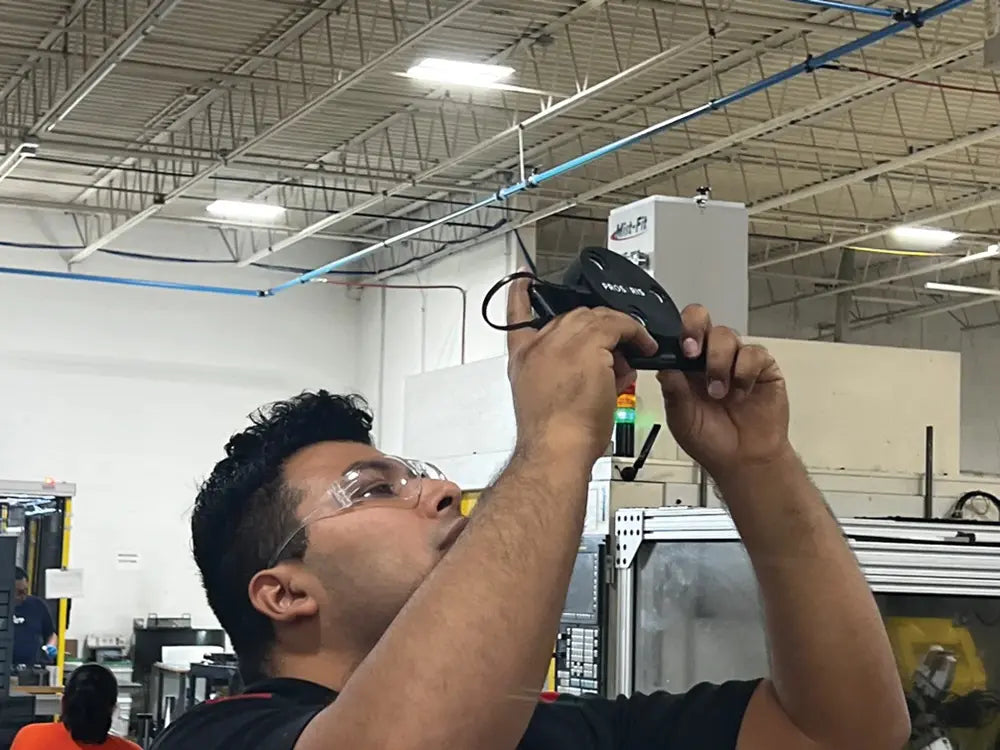
Air leaks are very common in compressed air systems. Finding and fixing leaks is one of the best energy investments you can make for your plant. In fact, by lowering the energy costs for your compressed air system, leak repair pays for itself — and your energy company may even help cover the costs of a leak study and repair service.
The Fluid-Aire Dynamics Leak Detection and Repair Program
Proactive leak detection and repair could help you save thousands on your annual energy bill. The Fluid-Aire Dynamics Leak Detection and Repair program is the easiest and fastest way to take care of leaks in your compressed air system. We use advanced tools and methods to reduce downtime, lower costs and enable better leak management for our industrial compressed air clients.
Here’s how it works:
- Our technicians use an advanced ultrasonic leak detection system by Prosaris, which provides highly accurate and reliable leak detection. The smart device connects to a smartphone or tablet so the technician can quickly identify compressed air leaks in large and complex systems and pinpoint their exact locations.
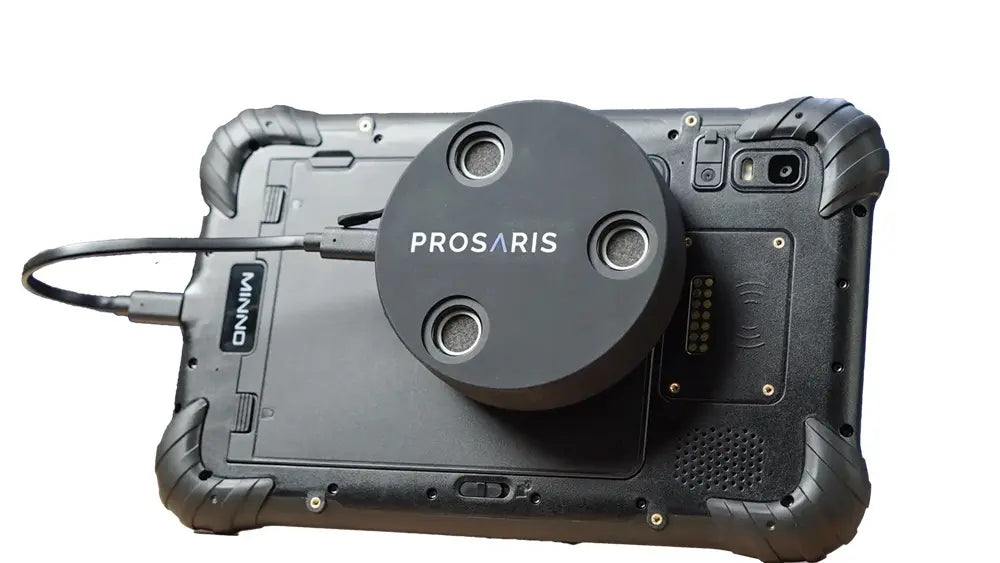
- A comprehensive report is then generated detailing your overall leak rate and where leaks are found, including an estimate of the air loss rate for each leak, how much each leak is costing the plant in wasted energy, and the estimated cost of repair. This automated report will help you quantify the return on investment (ROI) for leak repair and decide which leaks are worth repairing now and which to leave alone and keep an eye on.
- In many cases, we can make repairs for small, easily accessible leaks the same day (e.g., those in the “dirty 30” or located at 10’ or lower). The technician will make sure each section can be safely depressurized before starting repairs. We can work with you to schedule repairs at the most convenient time to minimize disruptions to your operations.
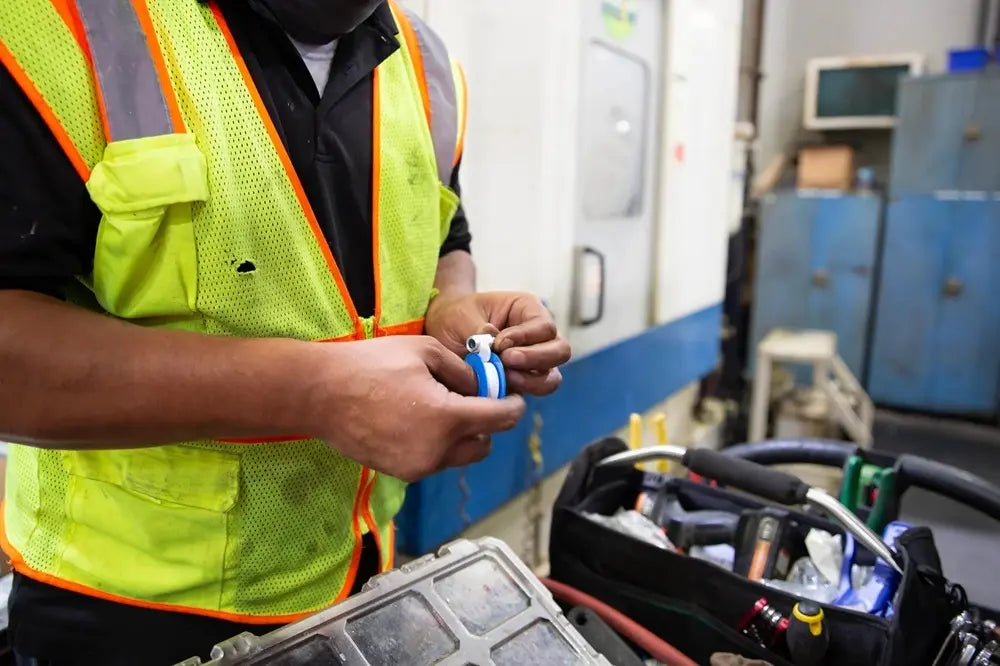
- Larger leaks and those requiring specialized tools and materials may require a return visit. We will work with you to develop a budget for leak repair, prioritize repairs based on ROI, and set up a long-term plan for leak management and system optimization.
If you qualify for incentives for leak repair through your energy provider, we’ll take care of the paperwork for you to make sure your project is covered. Many energy providers and energy consortiums — including ComEd, Xcel, Focus on Energy, DTE and Consumers Energy — incentivize leak detection and repair for compressed air systems as part of their energy incentive programs. These incentives may cover part or all of the study and repair costs.
If you are not in an area with a participating provider, we charge competitive rates for leak studies and repair. Many leak studies can be conducted with a single day of labor (larger or more complex systems may require two). Repairs that are made the same day are charged for materials only, with no extra labor costs. We will provide a written estimate for any repairs that would require a return visit. You can also choose to do the study only, without any repairs. In most cases, the ROI for leak repair more than justifies the investment; companies save much more in energy costs than they spend on repairs.
How Common Are Compressed Air Leaks?

Leaks are widespread in all compressed air applications. In the average manufacturing operation, 20-30% of the total energy consumption is for compressed air used to power air tools and pneumatic equipment. On average, 30% of that expense is due to compressed air leakage.
A high leak load means you have less air to do work, and your air compressor system must work harder to maintain normal operating pressure, adversely affecting production and leading to decreased service life for the air compressors. If the leak load is high enough, you may even find yourself adding unnecessary compressor capacity to compensate.
Estimating Leak Rate for the Compressed Air System
Our compressed air leak calculator can help you determine how much air your facility may be losing to unplanned leaks.
There are a couple of ways to estimate the leak rate for your compressed air system:
- Measure the compressor output when idle: First, ensure all equipment using compressed air is turned off. Then, record how often and for how long the compressor runs to maintain system pressure. This is when the compressor is compensating for the leaks. If you know the compressor’s output rate (in cubic feet per minute or CFM) and it runs for a certain period (say, 10 minutes every hour) to maintain pressure, you can estimate the total leak volume per hour.
- Utilize pressure drop information: Sudden or excessive pressure drop in a compressed air system can be an indicator of a high leak rate. Pressure drop can be measured by comparing the readings of a pressure gauge at the compressor outlet and a pressure gauge downstream or at the end of the distribution run. Rapidly falling pressure between two points in an otherwise unobstructed pipe run (e.g., no blockages or clogged filters) often indicates a leak somewhere between the points. (However, ultrasonic detection is a much faster and more accurate way to locate individual leaks).
How Much Do Compressed Air Leaks Cost?
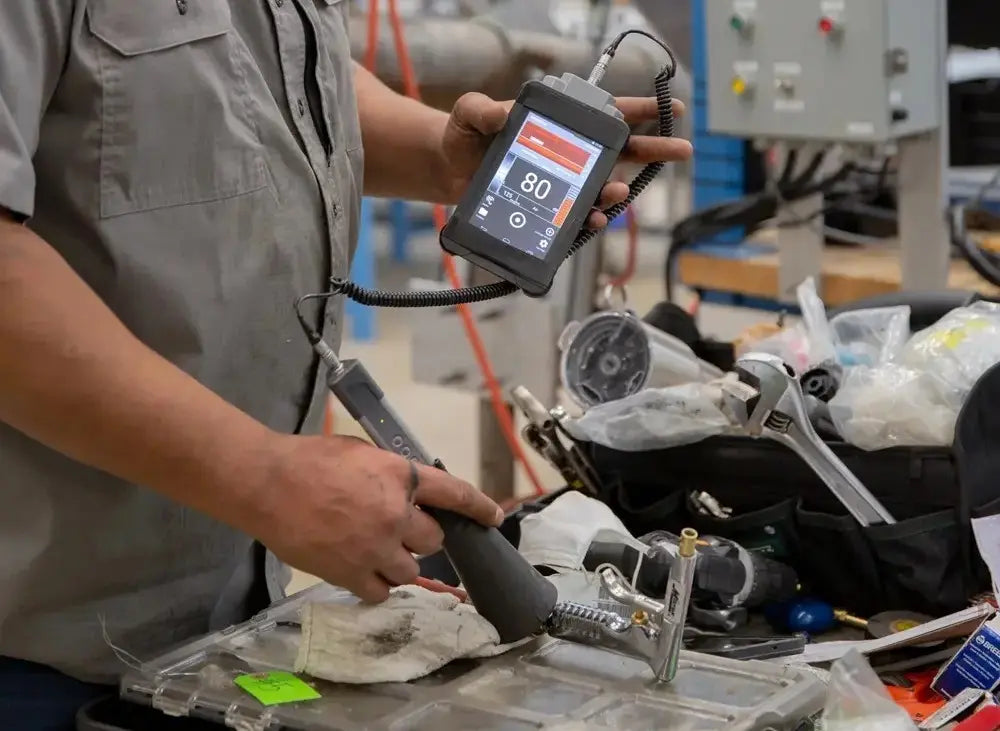
How costly are compressed air leaks? Here are two examples to put the cost of leaks into perspective:
- Possible annual cost: Let’s look at the possible annual cost for a 100,000 sq foot manufacturing facility. According to Madison Gas and Electric, the average manufacturing facility uses 95.1 kWh of energy per square foot per year. That means this facility would use approximately 9.51 million kWh, with approximately 2.37 million kWh (25%) used for compressed air. With a leak rate equal to 30% of the total system volume, there is a waste of about 713,250 kWh per year. If they pay $0.10/kWh for energy, this plant is wasting approximately $71,300 on compressed air leakage each year! This is money that could be put to better use by investing in their business or improving cash flow.
-
Per leak cost: In Figure 1, we show how much one specific leak could cost each year, depending on the size of the leak (in cubic feet per minute, or CFM) and the operating pressure (PSI) of the system.
| Cost of Compressed Air Leaks | |||
|---|---|---|---|
| Hole Diameter (in) | Energy Loss at Pressure (kWh/year) | ||
| 110 PSI | 110 PSI | 90 PSI | |
| 3/8" | 226,100 kWh | 208,100 kWh | 190,000 kWh |
| $ Wasted @ $0.10/kWh | $22,610 | $20,810 | $19,000 |
| 1/4" | 100,500 kWh | 92,500 kWh | 86,300 kWh |
| $ Wasted @ $0.10/kWh | $10,050 | $9,250 | $8,630 |
| 1/8" | 25,100 kWh | 23,100 kWh | 21,100 kWh |
| $ Wasted @ $0.10/kWh | $2,510 | $2,310 | $2,100 |
| 1/16" | 6,300 kWh | 5,800 kWh | 5,300 kWh |
| $ Wasted @ $0.10/kWh | $630 | $580 | $530 |
| 1/32" | 1,600 kWh | 1,400 kWh | 1,300 kWh |
| $ Wasted @ $0.10/kWh | $160 | $140 | $130 |
Table 1: Cost of Compressed Air Leaks
Reference
Where Leaks Form in the Compressed Air System
In an industrial compressed air system, most leaks are found in the “dirty 30” — the last 30 feet of hoses, connectors and fittings before the application. Common places leaks develop in the distribution system include quick couplers, disconnects, pipe joints, and rubber hoses and seals. Poorly maintained systems may have dozens of leaks. Many of these types of leaks can be easily and quickly repaired on-site once they have been located.
If you suspect a leak in the air compressor itself, that also needs to be addressed promptly. Air compressor leaks or leaks in the air receiver tank are usually best addressed by calling in a professional.
How to Detect Leaks in the Compressed Air System
There are some main ways to detect leaks in a compressed air line or piping system.
1. Listen for Leaks
Sometimes, you can walk around the plant, following the compressed air lines, and hear the hissing of a leak as you walk by it. Unfortunately, this isn’t always effective. Often, the noise of an operation makes the audible sound of a leak hard to detect, and piping may be near the ceiling and far above the floor. It is best to perform audible leak detection during the off hours or on the weekend when the plant is not in operation. Still, smaller leaks may be entirely inaudible to human senses.
2. Soapy Water Test
If you have a general idea of where the leak is located, a soapy water test can help you pinpoint the exact location. This test is simple: just apply soapy water to piping or connectors where a leak is suspected. If soap bubbles form, you have found your leak. This method is effective but can be time-consuming and requires easy access to the piping. It also does not provide an estimate of the size of the leak.
3. Ultrasonic Acoustic Detector
Ultrasonic leak detection devices pick up the high-frequency hissing sounds (noise waves) that a leak makes. This equipment often includes directional microphones, amplifiers, and audio filters. A visual indicator or headphones are used to see or hear leaks. This method is a fast and reliable way to accurately detect and locate compressed air leaks, even those leaks that are too small to create a noise audible to the human ear. It also provides an estimate of how much air is being lost to each leak.
Here’s how an ultrasonic leak detector works.
- When compressed air is flowing through a pipe, it is moving in a laminar flow. This type of compressed air flow means all particles are streaming in the same direction and in a parallel manner. (See Figure 1.)
- When there is a leak in the pipe, the airflow around the leak changes to turbulent flow. The air is not moving in the same direction. (See Figure 2.) This turbulent air creates a noise that is interpreted by ultrasonic detectors. Directional microphones allow the detector to pinpoint the exact location of the leak.
- The ultrasonic leak detector will work in one of two ways. An auditory system connects to headphones that produce a sound that gets louder when a leak is present. Visual systems will have a screen showing the ultrasonic waves. Changes in the waveform as the sound gets louder indicate that you are nearing the source of the leak.
- Ultrasonic detectors filter out background noise so that leaks can be heard or seen even in very noisy environments.
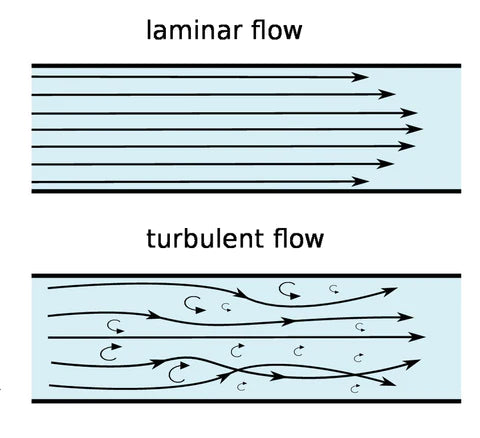
How to Fix Air Leaks
Many compressed air leaks are simple to repair and can be fixed the same day they are detected. The complexity of the leak determines how involved the repair will be.
1. Depressurize the System
Be sure to depressurize the system or isolate and depressurize the portion being repaired before conducting leak repair.
2. Tighten Connections
A quick fix for some leakage is to simply tighten the connections. This can save thousands each year in electricity and takes very little time or effort.
3. Repair or Replace Damaged Parts
Most leak fixes are a bit more involved. These include the replacement of couplings, fittings, pipe sections, hoses, joints, drains, and traps.
4. Replace Leaky Hoses and Connectors
If the leak is in a hose, tube or quick-coupler, it is best to swap out the faulty hose or connector for a new replacement.
5. Repressurize and Test
After repairs have been conducted, repressurize the system and retest to see if the air leak has been resolved.
IMPORTANT NOTE: If you do not have experience detecting and fixing compressed air leaks, we recommend working with a professional to detect and repair the leaks in your system.
How to Reduce Leaks for the Future
It may be impossible to stop air leaks for good, but proper maintenance of the compressor system and distribution piping will reduce the leak rate and go a long way toward reducing wasted energy for the system.
- Ensure that fittings, disconnects, hoses, and tubing are all high quality.
- Make sure thread sealant for connectors is properly applied.
- Isolate all non-operating equipment with a valve in the distribution system.
- If you have an older distribution system with a high leak rate, such as black iron piping, consider upgrading to a modern aluminum piping system, such as Unipipe. Aluminum piping has a much lower leak rate and can be installed without threading, brazing or welding.
- Where possible, lower the air pressure of the system. This is effective because the flow rate decreases when the system pressure drops, so less air leaks out of the line. Many plants are operating at a higher pressure (PSI) than necessary, so lowering plant pressure can make a big difference.
- Remember that leak management is an ongoing process; new leaks develop frequently, especially in older piping systems. Regular leak detection and repair, along with an annual complete system audit, can help manufacturers ensure operational efficiency.
Schedule Your Leak Study Today
Finding and fixing leaks generates energy savings that more than pay for the costs of repair. Fluid-Aire Dynamics offers complete compressed air system audits as well as basic leak detection and repair. We use advanced leak detection technology, including ultrasonic leak detection, to pinpoint compressed air system leaks. Contact us to learn how you may qualify for energy incentives for compressed air leak repair.
